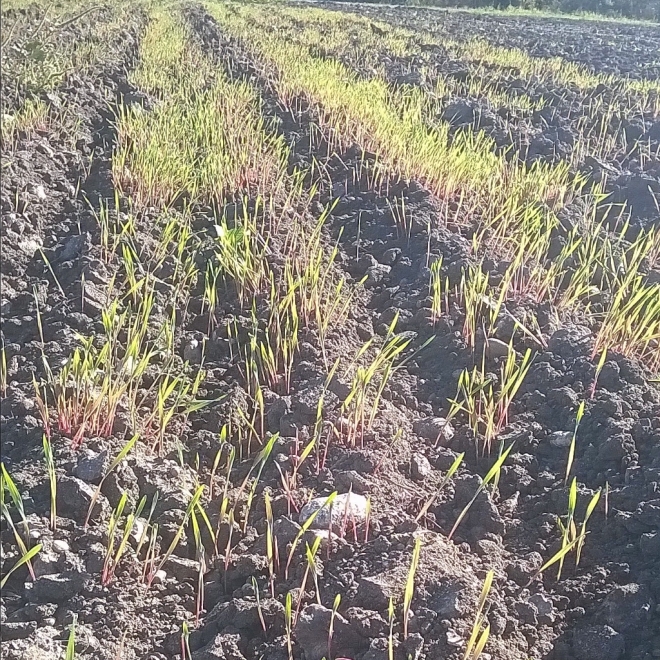
Despite the lack of rain wheat is germinating. Dense seeding helps to suppress weeds. The wheat will grow throughout the winter and reach maturity in the Spring.

Despite the lack of rain wheat is germinating. Dense seeding helps to suppress weeds. The wheat will grow throughout the winter and reach maturity in the Spring.
This annual event is happening tomorrow at Mission San Juan from 10am-3pm. Free and open to the public it will feature free produce, cooking demos, fun activities for all ages, and of course an opportunity to check out the farm operation. We’ll be roasting pumpkin and squash grown in the fields in an adobe horno for people to try and I will be available to talk about what is growing. Come on out and get some veggies.
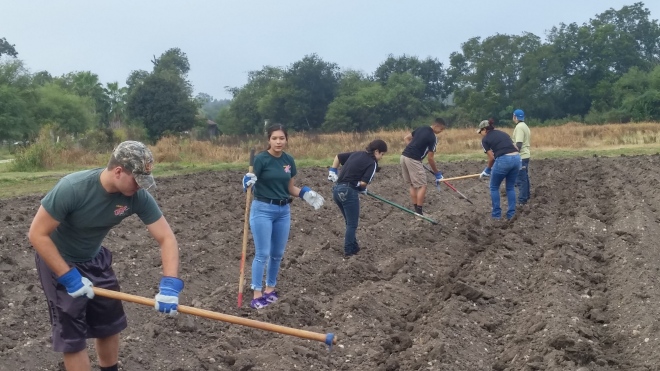
The McCollum High School ROTC helped out last Saturday. We set up a few new sections for planting winter crops. Onions, garlic, lentils, fava beans, and cabbage are next in line to get planted. Lots of work left to do but we made some good progress!

Above are some savoy cabbage from last winter. It’s that time again. Join in this Saturday as we plant a new crop of cabbage and cool season legumes. 9am- 12pm. Bring a friend and get your hands dirty!
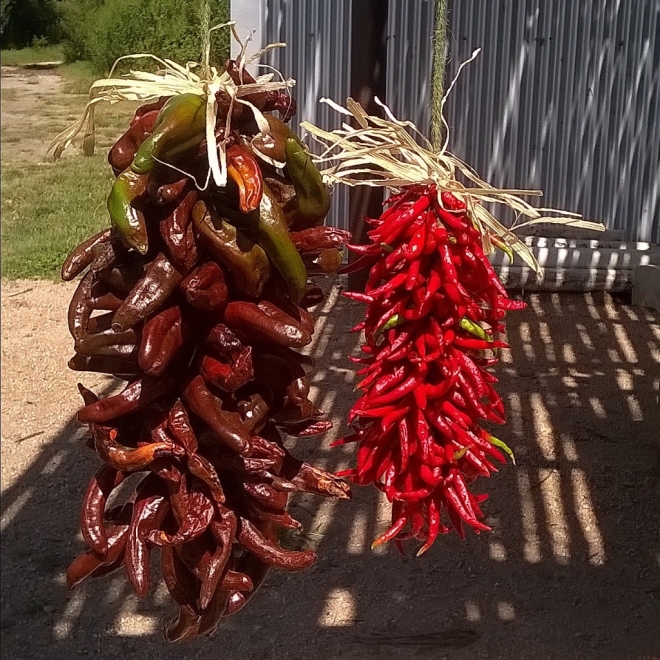
We learned how to make a ristra this past Saturday. This is a traditional way of drying peppers. Utilizing some string and lots of knots the peppers can be hung up while getting proper air flow to prevent them from spoiling as they dry out. The dry peppers can be rehydrated by soaking them in water or ground into powders to be used in a variety of culinary applications.

Here’s a look at yesterdays cushaw squash harvest with some Seminole pumpkins tucked in. These squash are produced by trailing vines that can stretch out well over 10 feet. They are a native variety of winter squash which means they take longer to mature and end up with a tough exterior. They are ideal for roasting at this stage. The flesh becomes tender and can be used for either sweet or savory dishes. There is one more harvest left from plantings made early in the summer. Tomorrow we will be clearing out the area and prepping for fall.
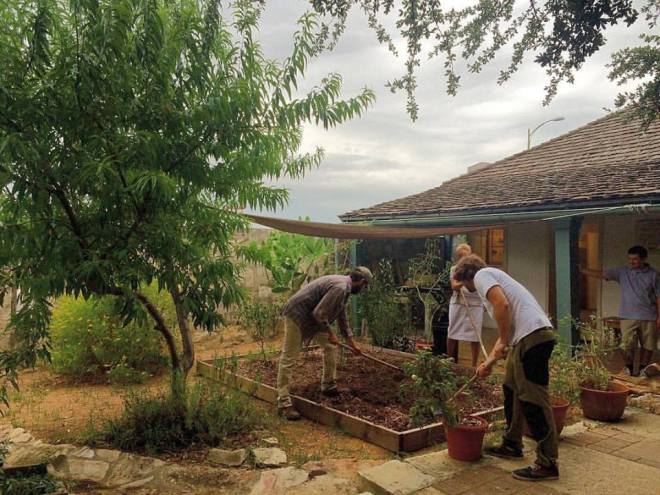
The work day at Casa Navarro was a success. We worked in the garden clearing, weeding, and planting beans and squash. We discussed growing vegetables and herbs in containers, potted more tomatoes, thyme, rue, and talked about preparing for the fall season. Thanks to everyone who came out.
I’ll be back at it this Saturday at Mission San Juan from 9am- 12pm.

The heat is here in full force. The weather forecast repeats triple digit high temperatures throughout the weeks: welcome to summer in South Texas.
Though this time of year is not the most pleasant there are some advantages that come with dry heat. The corn pictured above has been dried to perfection. You will notice a couple of things about this piece of corn. First, it isn’t yellow. Many heirloom (typically “heirloom” simply refers to domesticated plant and animal breeds from before 1850) varieties of corn were amazingly colorful. Corn is wind pollinated and is incredibly prone to swapping genetic information which can lead to an abundance of diversity when it comes to the traits of the plant. Over the course of time growers can create stabilized breeds that are suited for specific regions, environments, needs, and tastes of people.
The blue corn pictured above you will also notice has dents in the kernel. Dent or field corn are terms that refer to corn that is primarily grown to be dried and then ground into flour or used for animal feed.
The kind of corn most people are familiar with, the yellow stuff you encounter at the grocery store, is referred to as sweet corn. It too can be dried. The same dents will appear and it can be ground into cornmeal or processed into masa.So what is the difference? Well to answer that I will have to explain a bit about maturation process of the plant.
If you look back a few months in time at the blog there is a section where I talk about pollination. As the corn matures after pollination complicated things are happening inside that husk. Sugars and starches are being formed and developed in each little kernel. The sweet corn we all know and love represents a phase in the process called the “milk stage”. The term specifically refers to moisture content. When checking to see if sweet corn is ready you can peel back the husk and puncture a kernel with your nail. It will exude a milky liquid hence the name of this stage. If the liquid is clear then it isn’t ready yet. If the kernel is hard or doughy, then it has passed the milk stage. Sweet corn has been bred and selected for the qualities it has in the milk stage. It is meant to be eaten fresh or roasted. Field corn, dent, or popcorn are words that refer to varieties meant to be dried. They still go through the milk stage but pass through it more quickly.
The advantage of dried corn is that it can stored for longer periods of time. This would have been an essential quality before refrigeration as this dry corn could be stored in a granary for months and processed in a variety of ways. During the mission period in San Antonio corn was essential for sustaining the dietary needs of the people on the northern frontier of New Spain. Historical and archeological records show that it was being cultivated on a massive scale throughout the San Antonio river valley through the 18th century.
Now that there is a good supply of dried corn we can start processing it. Stay tuned!
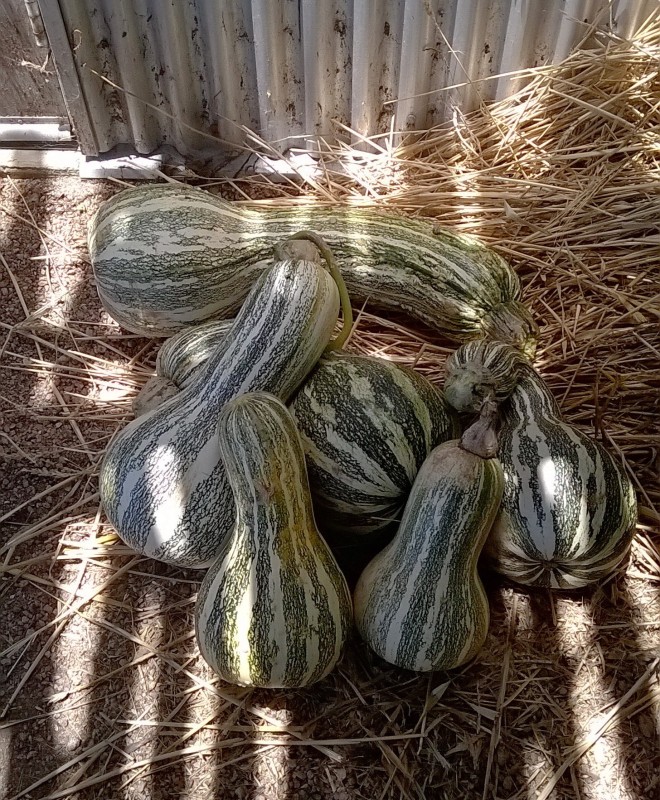
Seeds saved from a seed grant the farm received from native seeds last fall have produced these beautiful Tarahumara cushaw squash. This variety thrives in south Texas; it doesn’t seem to mind the heat or pests that afflict squash in our area. They are prepared much like a pumpkin or butternut squash. Roasting the squash results in a tender orange flesh that could be used for both savory or sweet dishes. Cushaw pie anyone?
